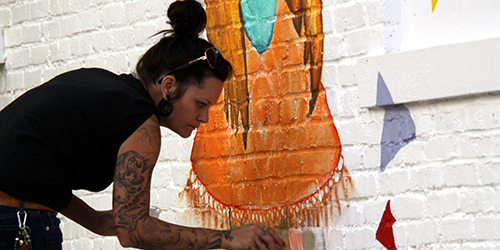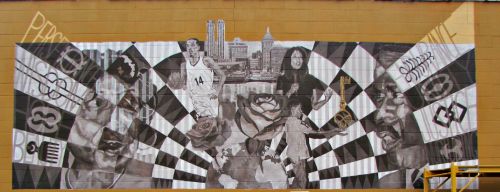New public murals are bringing vibrancy to their neighborhoods and enriching the community.
In case you hadn’t noticed, Peoria is paying close attention to public art these days. With the recent launch of Sculpture Walk Peoria, a slate of new sculptures is coming to the Warehouse District this summer. Meanwhile, new public murals are bringing color and vibrancy to their neighborhoods. Last June, the Whiskey City Collaborative arranged for a mural on the side of the Sunbeam Building at Main and Sheridan. About the same time, plans for murals along West Main Street and Western Avenue were beginning to take shape. With the city’s support, public art is humanizing the urban environment and adding meaning and uniqueness to the community.
Signs of Life
Head east along Main Street from Bradley University, and you’ll soon encounter a curious sight. What once was an unassuming, white-brick warehouse at 909 and 911 West Main now bursts with life. A colorful, 12’-by-78’ mural graces the Muir Building’s west side, while six large-scale panels adorn its front, beckoning to passersby along West Main.
The public art project was among the first to utilize the City of Peoria’s revised mural code and permit process. Working with Muir Omni Graphics—the building’s owner—and the Renaissance Park Community Association (RPCA), a group of local artists came together to bring the benefits of public art to the neighborhood.
The project began to take shape last June, when Andrew Muir, president of Muir Omni Graphics, was presented with the concept. “The Muir family was very eager to help,” says Jessica Ball, RPCA board member and owner of The Art Garage down the street. The positive response led to the formation of a public art committee, chaired by Ball, and a citywide call-out for artists.
“For the painted portion of the mural, interested artists were asked to submit a draft picture of a figure, human or otherwise, in a pedestrian or walking manner,” notes Ball. “The printed panels were chosen from already-existing, finished works submitted by interested artists. Muir Graphics used their new, state-of-the-art equipment to print these out on a special material that would work in outdoor conditions.”
A Walkable West Main
Artist Shannon Slaight-Brown works in both two and three dimensions, in sculpture and prints, and participated in both the mural and the panels on the Muir Building. It’s her pattern of colorful triangles—which appear to float from the young girl’s balloon out above the heads of her fellow pedestrians—that serves to connect the mural’s various characters. They are young and old; male and female; black, white and even purple. There’s a peacock, a Ninja Turtle and numerous unearthly-looking creatures—all the work of multiple artists with different styles.
“Each artist’s unique style… represents the diversity that makes up this area,” Ball explains. “The use of several artists pays homage to the creative activity that has brought new pride and interest to this neighborhood. And we wanted to reflect our vision for a walkable West Main.”
Where the mural is an unstructured hodgepodge—the glorious mess of urban living—the panels on the front of the building are the same size, their placement and symmetry offering stability where the mural suggests movement. But each is quite different from the next, making a walk past the building an eclectic journey of eye candy, ranging from avant-garde photography to abstract geometry to collage.
Raphael Rodolfi’s “Peoria, Tiny Planet” is among the most striking of the panels. His photograph bends a traditional shot of the Peoria skyline into a 360-degree circular view with the Illinois River at its center. “I love this picture because of its vibrant colors, the reflection of the buildings in the water, and the bridge that wraps around you and wants to take you for a slide right into downtown,” muses the ubiquitous photographer and videographer, who cites Peoria as his inspiration.
“It is still a ‘new’ place for me since I didn’t grow up here,” he adds. “It is easy to take our city for granted—this is why I like to capture places, buildings and details that we are used to seeing but tend to overlook. Then I like to add a layer of creativity and spice up a detail to make… something memorable.”
An Approved Use
Because the project was considered an exterior modification, the RPCA had to obtain a building permit from the City of Peoria. Thanks to mural-related ordinance changes passed by the City Council last summer, it was a smooth process. “Had those ordinances not been amended, we would have had to seek permission for a ‘special use’ through the Planning and Zoning Commission and City Council,” notes Nick Viera, RPCA board member, “which would have been significantly more time-consuming.”
“The City of Peoria has been very helpful and supportive of this project,” Ball adds. “I believe the city understands the benefit of public art in its community.” And while the project was completed at the end of last year and dedicated in early February, there has already been discussion of adding to it in the future. As the West Main neighborhood continues to reinvent itself, public art is sure to be on the agenda.
Inspiration on Western Avenue
Another new mural has attracted attention on Peoria’s south side since its completion last fall. Created by Peoria artists R. Rashad Reed and Brenda Gentry, it’s painted on the building adjacent to TT’s Barbeque, a carry-out restaurant founded by Orlando Randle and his son, Maurice Cobige, just over two years ago. “Orlando made a suggestion to [Councilwoman] Denise Moore to get a mural on the wall in his parking lot—looking out over Western Avenue—of inspiring black heroes from Peoria,” recounts Gentry, who also worked on the Muir Building mural. “He helped with some paperwork, talked to the owner of the building, and really helped to make it happen.”
Reed, a painter and sculptor, was commissioned for the mural, which was funded by Greater Peoria LISC and the City of Peoria, through its façade improvement program. He tapped Gentry to assist. The two had previously worked together on a team of artists advising ArtsPartners and the Tri-County Regional Planning Commission on an arts and cultural plan for Peoria’s south side. Funded by a creative placemaking grant from the National Endowment for the Arts, the plan called for more public murals, sculptures, performance spaces and the like: to encourage resident creativity, celebrate the neighborhood’s cultural heritage and improve its aesthetics. The mural at TT’s, a rich tapestry of symbolism, is an example of this plan in action.
“That’s really the first time I ever considered doing a mural,” Reed explains, recalling his reaction to White’s piece. “I was able to sit there, soak it in and study it. It kind of set me on a course to make my mark… on the world or in the community, with the things that I create.”This isn’t Reed’s first piece of public art; he unveiled “Olmec Pryor,” a ceramic bust of the late Richard Pryor, in John H. Gwynn Park in 2012, and he’s worked on murals at a few local schools. Among his influences, he cites the great Mexican muralists, as well as artist Charles White, whose best-known work, The Contribution of the Negro to Democracy in America (1943), is on display at Reed’s alma mater, Hampton University. The mural depicts a number of prominent African-Americans, including Nat Turner, George Washington Carver, Harriet Tubman, Frederick Douglass and Marian Anderson.
Art + Soul
Concentric circles pulse outward from the half-earth bull’s-eye anchoring the mural’s bottom. Its perimeter is adorned with West African adinkra; behind each symbol, its meaning in English: perseverance, wisdom, hope, beauty, endurance, unity, justice, nurturing.

The idea for this mural, Reed explains, was to “honor people who served the community in the past… those who had achieved success in the present, and some ode to the future.” Four influential Peorians—two former legends and two current ones—were selected for inclusion. Long-time community leader, the late Annie Jo Gordon, and former NAACP president John Gwynn, Jr. exchange looks from either side of the mural; NBA pro Shaun Livingston and Gordon’s daughter, Rep. Jehan Gordon-Booth, secure the middle third against a backdrop of the Peoria skyline.
A golden key, the only splash of color, hovers slightly above the hand of a young man—an ode to the future—while two concrete roses rise from the earth beneath the sports hero and the legislator: “a loose analogy of succeeding from within difficult circumstances,” according to Reed. “It’s no secret that many of our young African-American boys and girls face adverse circumstances… This piece stands to represent many of those people who have succeeded despite those obstacles.”
With this creation, Reed has fulfilled his objective—“to spark a flame of knowledge”—and made an enduring mark on his community. Encouraged by the city’s embrace of public art—and with ideas for future projects—he’s hopeful that more opportunities for area artists lie just around the corner. a&s


